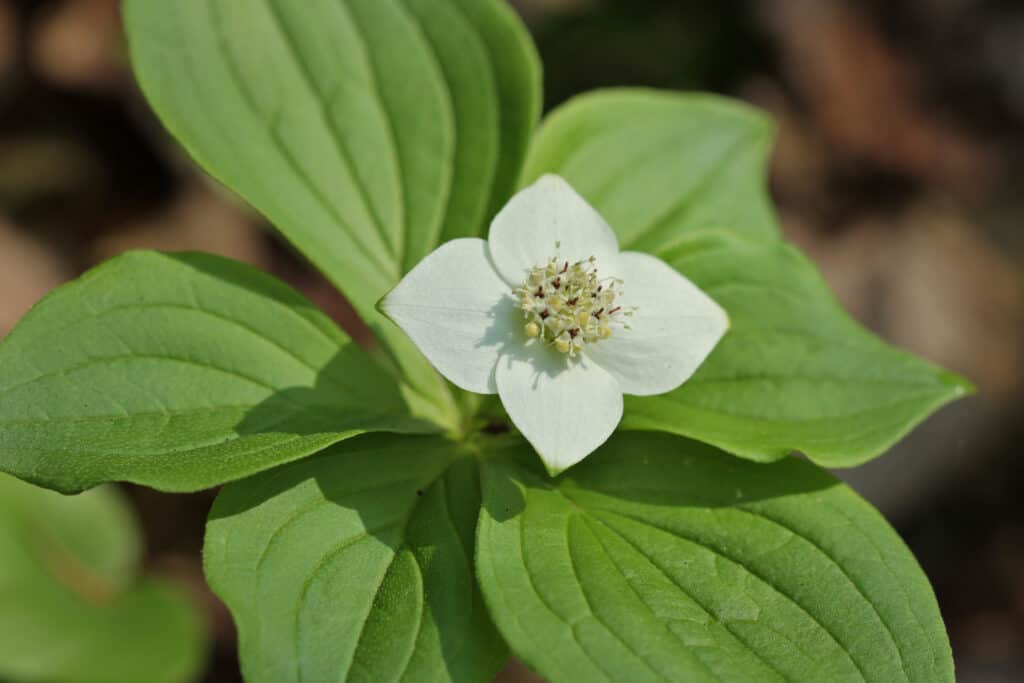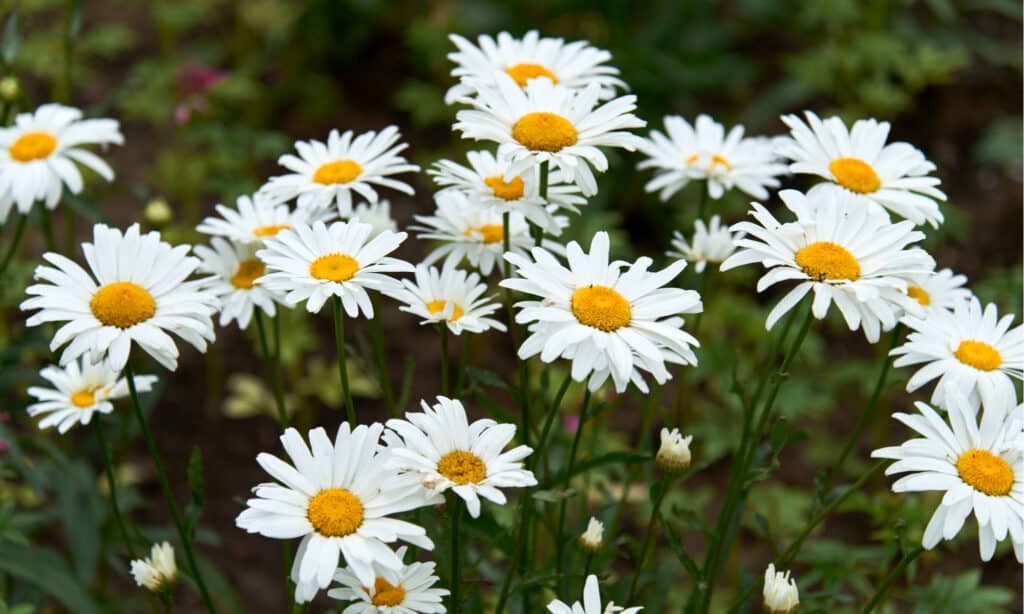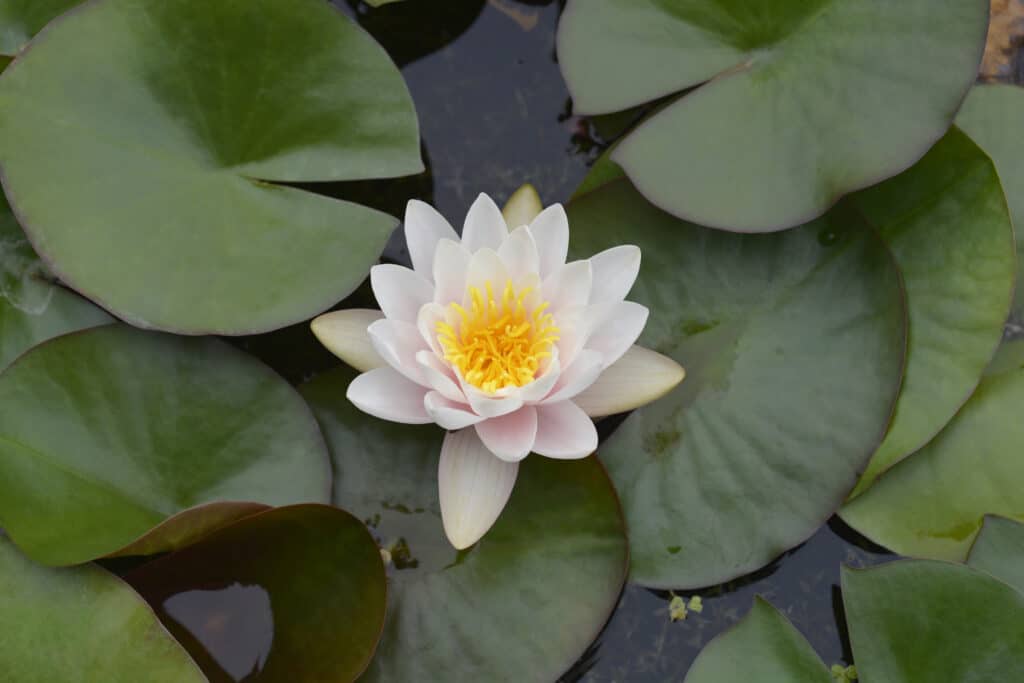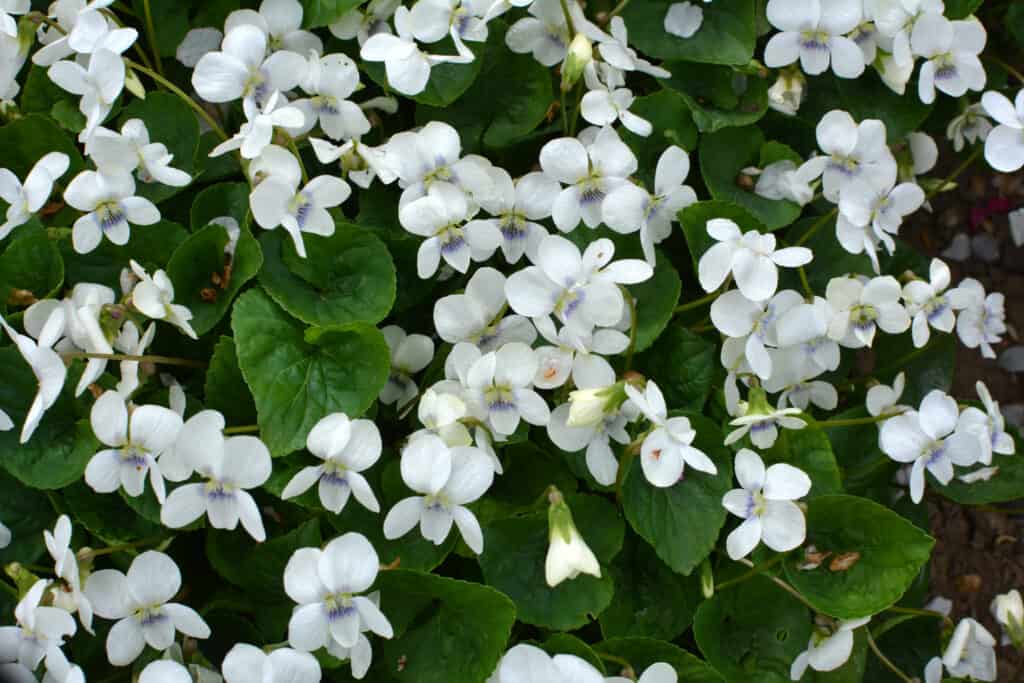What’s that delicious smell? It’s squirrel corn! These white perennial flowers are native to North Carolina, Missouri, and Southern Canada. They attracts chipmunks, mice, and squirrels.
Squirrel corn (Dicentra canadensis) has spherical tubers on the roots resembling corn kernels. Admirable heart-shaped flowers hang from a short stock. You can find it living wild throughout the woods. It is the perfect flower to add to your garden since it’s easy to grow and spread rapidly.
What other white perennials should you know about? Read on to find out!
1. Bunchberry

The Canadian dogwood, also called Quatre-Temps (
Cornus canadensis/ Canadian bunchberry, Bunchberry dogwood)
©iStock.com/Yves Dery
Get ready to meet a relative of the flowering dogwood tree—the famous bunchberry! Originally from Asia, you can find bunchberry throughout Southern Canada. Roadsides, meadows, and waste spaces are some of the most popular spots.
The four small petals of each flower have a bright white color. The petals look more like leaf-like bracts under a cluster than flowers. Growing only three to five inches tall, this plant also produces adorable red berries.
You can quickly identify white bunchberry perennials by looking at the leaves. You’ll find six broad leaves with sharp points in a whirl. Petite white petals will surround the center group of tiny flowers.
What animals like bunchberry? The fruits of this perennial are a favorite of birds like ruffed grouse and ptarmigan. You’ll also find thrushes, waxwings, and game birds munching on the berries.
2. Daisies

Daisies are happy-looking flowers that are often used to brighten someone’s day.
©Smyshliaeva Oksana/Shutterstock.com
Another one of the best white perennial flowers originating from Asia is the daisy! Daisies have been spreading throughout Europe and England. They’re also prevalent throughout North America. It’s believed that seeds came through hay or grain carried on the boats of early colonists.
Oxeye daisies help create the popular hybrid we see today, Shasta daisies. You can identify the flowers by looking at the leaves. The leaves sit at the base of the plant and on the stem; they’re narrow with shallow lobes. Every flower head has brilliant white ray flowers. The rays cascade from a vibrant yellow disk flower.
Another great characteristic of daisies is that they attract butterflies! If you want to bring some life and color to your garden, daisies are a perfect choice.
3. Water Lilies

Water lilies are beautiful white perennial plants that provide food for
fish
and wildlife.
©iStock.com/Nahhan
One of the more unique white perennial flowers is the water lily. Water lilies have undergone incredible evolutions, providing them with special gifts. They have enhanced scents, colors, and movements. Every day, around 11:00 a.m. and 3:00 p.m., water lilies put on quite a show. Their floral movements involve opening right around 11:00 a.m. they soak up the sun throughout the day and close at 3:00 p.m. Water lilies have lovely white flowers that can sometimes be pink. There are so many petals on these gorgeous perennials, and they float delicately.
Water lilies are popular in lake coves and ponds, and bloom between June and September. After pollination, the flowers stay closed, and the flower stem coils. The developing fruits are pulled under water. Once ripe, the flowers burst! The seeds float to the surface. Dispersing with the current, new flowers begin to propagate.
Did you want to grow water lilies for yourself? After purchasing plants, you’ll want to plant them with the roots buried deep in the mud. Look for mud at the bottom of a pond and hold the flowers in place with a rock. You’ll find these white perennial flowers spread each year.
4. Bloodroot

Bloodroot is a perennial flower is sometimes also called bloodwort, red puccoon, redroot, black paste, and
Canada
puccoon.
©iStock.com/vasare
If you’re looking for a striking white perennial, look no further than bloodroot. Early in the spring, these perennials bloom with one to three large white flowers. The petals have a delicate “S”-shape, and some varieties have a fringe along the edge.
The name bloodroot comes from the red sap that seeps out when the roots or stem are cut. This sap was used as a dye and medicine by Native Americans. You’ll find these white perennial flowers growing in deciduous woodlands from Nova Scotia to Georgia and Minnesota. They’re also native to Florida and Oklahoma.
As one of the earliest bloomers, bloodroot can be found in late March or early April. The blooms only last a few days, but they are worth checking out! Pro-tip: they prefer shaded areas with moist soil rich in humus.
5. White Trillium

The White Trillium is the official emblem of the Province of Ontario and the State Wildflower of
Ohio
.
©iStock.com/SHSPhotography
Nicknamed large-flowered trillium, the white trillium is one of the most popular choices for wildflower gardens. These white perennial flowers are impressive. After pollination, the flowers start to change from white to shades of pink. Trilliums take 6 to 8 years to have their first blooms, so you’ll have to be patient.
You can easily identify these white perennials in the wild by looking at the large pointed leaves at the top of the stem. There should be three leaves along with three-petaled white flowers. The flower will turn slightly upwards unless it’s the nodding variety. Nodding trilliums are also white colored, but they have a green tinge. The flower is inconspicuous and hangs down. Bumblebees accidentally pollinate nodding trilliums, helping them thrive throughout the woods.
These flowers are native to southern Canada and throughout the northern United States. You’ll also find nodding trilliums throughout Maine and the Great lakes area. You can even find them in mountain environments. However, a lot of the trillium varieties appear in woodland habitats. Trilliums love to bloom between April and June and need partial shade and rich organic soil. They do best when mulched with rotted leaves every year.
6. Canada Violet

White violets (Viola canadensis) can be found through much of the
United States
and Canada.
©iStock.com/Orest Lyzhechka
Enjoyed in the wild or grown in your garden, Canada violet is a must-see perennial. This plant doesn’t have a lot of flowers, but the ones it does have are white with a hint of purple on the back. The white perennial flowers are borne in the leaf axils.
The leaves are toothed, heart-shaped, and grow from a purplish stem with fine hairs. The flowers self-pollinate and develop seeds. The seeds are shot from a pod after it dries and squeezes. It’s an incredible process.
Canada violet perennials are native to the southern Appalachian Mountains. They are also native to Southern Canada and several northern states in the U.S. You’ll find many of them in rocky wood environments, and they bloom between April and July.
Growing only 10 to 15 inches tall, this perennial has partial shade requirements. Since seeds itself, it’s a low-maintenance plant, making it great for beginners.
Up Next:
The photo featured at the top of this post is © Wonderplay/Shutterstock.com
Sources
- Gardening.org, Available here: https://gardening.org/white-flowering-perennials/
- Gardening Know How, Available here: https://www.gardeningknowhow.com/ornamental/flowers/10-white-perennials.htm
- National Park Services, Available here: https://www.nps.gov/mora/learn/nature/forest-wildflowers-white.htm
Thank you for reading! Have some feedback for us? Contact the AZ Animals editorial team.






